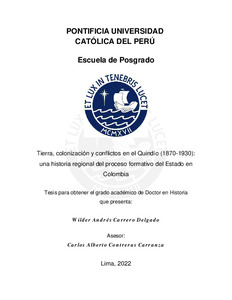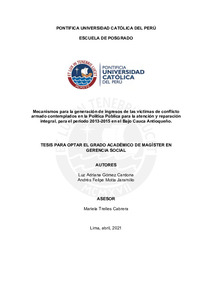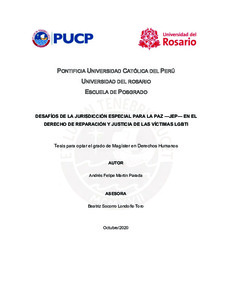| dc.contributor.advisor | Contreras Carranza, Carlos Alberto | |
| dc.contributor.author | Carrero Delgado, Wilder Andrés | |
| dc.date.accessioned | 2022-08-24T14:43:59Z | |
| dc.date.available | 2022-08-24T14:43:59Z | |
| dc.date.created | 2022 | |
| dc.date.issued | 2022-08-24 | |
| dc.identifier.uri | http://hdl.handle.net/20.500.12404/23173 | |
| dc.description.abstract | Entre el siglo XIX y XX, la ampliación de la frontera agrícola colombiana fue uno de los
principales proyectos públicos y privados diseñados para generar riqueza, acortar
distancias, fortalecer la presencia institucional en las fronteras, y reducir la conflictividad
en donde había alta presión demográfica; sin embargo, este proceso tuvo entre sus
principales características los conflictos entre colonos, cultivadores, agentes de Estado y
empresarios territoriales, ya que todos se vieron inmersos en reclamos por el derecho a la
propiedad de la tierra.
Es en este contexto que emerge la Provincia del Quindío como uno de los principales
centros de colonización y conflictos agrarios, pues a falta de catastro y control migratorio,
fue común que coincidieran en un mismo predio colonos, empresarios territoriales y
poblaciones recién fundadas las cuales, para garantizar el triunfo de sus intereses,
recurrieron a múltiples estrategias tales como falsificar escrituras, estimular el conflicto
entre terceros, e incluso, aprovechar su lugar político, especialmente cuando se trató de
agentes de Estado, para beneficiar intereses particulares; de allí que la colonización del
Quindío ofrezca múltiples experiencias de organización y resistencia campesina, como
también, un abanico de situaciones en las que podemos analizar el funcionamiento de las
burocracias, el control a las autonomías de los agentes estatales, la construcción territorial
de la región, las disputas entre el centro y la periferia, la transformación de la legislación
que reguló la propiedad de la tierra entre el siglo XIX y XX y por ello mismo, el proceso
formativo del Estado. | es_ES |
| dc.description.abstract | Between the 19th and 20th centuries, the expansion of the Colombian agricultural frontier
was one of the main public and private projects designed to generate wealth, shorten
distances, strengthen institutional presence on the frontiers, and reduce conflict where there
was high demographic pressure; however, one of the main characteristics of this process
was the conflicts between settlers, farmers, state agents and territorial entrepreneurs, as all
were involved in claims for the right to land ownership.
It is in this context that the Province of Quindío emerged as one of the main centres of
colonisation and agrarian conflicts, because in the absence of a land registry and migratory
control, it was common for settlers, territorial entrepreneurs and newly founded settlements
to coincide on the same land, which, in order to guarantee the success of their interests,
resorted to multiple strategies such as falsifying deeds, stimulating conflict between third
parties, and even taking advantage of their political position, especially when they were
State agents, to benefit private interests; Hence, the colonisation of Quindío offers multiple
experiences of peasant organisation and resistance, as well as a range of situations in which
we can analyse the functioning of bureaucracies, the control of the autonomy of state
agents, the territorial construction of the region, the disputes between the centre and the
periphery, the transformation of the legislation that regulated land ownership between the
19th and 20th centuries and, therefore, the process of the formation of the state. | es_ES |
| dc.language.iso | spa | es_ES |
| dc.publisher | Pontificia Universidad Católica del Perú | es_ES |
| dc.rights | info:eu-repo/semantics/openAccess | es_ES |
| dc.rights.uri | http://creativecommons.org/licenses/by/2.5/pe/ | * |
| dc.subject | Quindío (Colombia)--Colonización--Historia-Siglo XIX | es_ES |
| dc.subject | Quindío (Colombia)--Colonización--Historia-Siglo XX | es_ES |
| dc.subject | Tenencia de la tierra--Colombia--Quindío--Historia | es_ES |
| dc.subject | Campesinos--Colombia | es_ES |
| dc.title | Tierra, colonización y conflictos en el Quindío (1870-1930) : una historia regional del proceso formativo del Estado en Colombia | es_ES |
| dc.type | info:eu-repo/semantics/doctoralThesis | es_ES |
| thesis.degree.name | Doctor en Historia | es_ES |
| thesis.degree.level | Doctorado | es_ES |
| thesis.degree.grantor | Pontificia Universidad Católica del Perú. Escuela de Posgrado. | es_ES |
| thesis.degree.discipline | Historia | es_ES |
| renati.advisor.dni | 10308674 | |
| renati.advisor.orcid | https://orcid.org/0000-0001-7691-2362 | es_ES |
| renati.author.pasaporte | AQ267735 | |
| renati.discipline | 222048 | es_ES |
| renati.juror | Suarez Espinosa, Margarita Maria | es_ES |
| renati.juror | Contreras Carranza, Carlos Alberto | es_ES |
| renati.juror | Zapata Velasco, Gaston Antonio | es_ES |
| renati.juror | Palacios Rozo, Marco Antonio | es_ES |
| renati.juror | Puente Valdivia, Javier | es_ES |
| renati.level | https://purl.org/pe-repo/renati/level#doctor | es_ES |
| renati.type | https://purl.org/pe-repo/renati/type#tesis | es_ES |
| dc.publisher.country | PE | es_ES |
| dc.subject.ocde | https://purl.org/pe-repo/ocde/ford#6.01.01 | es_ES |









